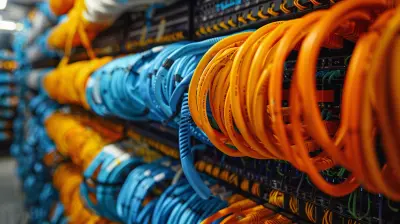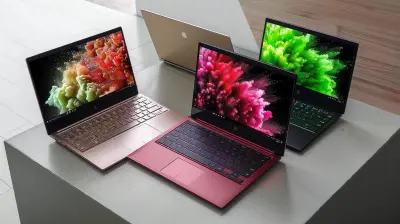The Benefits of High-Refresh-Rate Monitors for Professional Work
30 January 2025
When you think of high-refresh-rate monitors, the first thing that probably comes to mind is gaming. After all, gamers have been raving about 144Hz, 240Hz, and even 360Hz monitors for years, claiming they make all the difference in fast-paced games. But here's the thing: high-refresh-rate monitors aren't just for gamers anymore. These displays have quietly slipped into the professional world, and they’re making a huge impact in various industries. If you’re a designer, video editor, coder, or even someone who spends eight hours a day in front of a spreadsheet, a high-refresh-rate monitor can transform how you work.
Let’s dive into the real benefits of these high-refresh-rate monitors for professional work—and trust me, there’s more to it than just smoother scrolling.

What Is a High-Refresh-Rate Monitor?
Before we get into the nitty-gritty, let's clarify what we’re talking about here. The refresh rate refers to how many times per second the monitor refreshes the image on the screen. It’s measured in Hertz (Hz).So, a 60Hz monitor refreshes the image 60 times per second, which has been the standard for years. A 120Hz monitor? It does it 120 times per second. And those fancy 144Hz, 240Hz, or even 360Hz monitors? Well, they refresh the display at breakneck speeds, making everything appear buttery smooth.
For the longest time, 60Hz was considered “good enough” for most tasks. But as technology advances and screens get more sophisticated, it's becoming clear that higher refresh rates can make a noticeable difference in the way we work—not just in the way we play.

Smoother Visuals Equals Less Eye Strain
Let’s get real for a second. If you’re spending long hours in front of your computer, your eyes are probably feeling the burn. Whether you're working on detailed spreadsheets, coding for hours, or editing videos, eye strain is a common issue. A high-refresh-rate monitor can help reduce this discomfort.Here’s why: at higher refresh rates, the images and text on the screen appear smoother. This means less flicker and reduced motion blur. As a result, your eyes aren’t working as hard to follow what’s happening on the screen. It’s kind of like comparing a flip book to a smooth animation—your brain and eyes prefer the latter.
If you're someone who experiences headaches or fatigue after long sessions of staring at a screen, upgrading to a high-refresh-rate monitor may offer some relief. It's like treating your eyes to an ergonomic chair—once you try it, you’ll never want to go back.

Enhanced Productivity: Every Millisecond Counts
Time is money, right? Every little thing that improves your workflow can add up over time. While we often think of fast processors or tons of RAM as the key to productivity, your monitor’s refresh rate could be just as important.Think about it: when moving windows around, scrolling through long documents, or even just dragging files from one folder to another, a high-refresh-rate monitor makes everything feel much more fluid. There’s less lag, and actions feel more immediate. This might seem like a small thing, but those milliseconds add up throughout your workday.
For creators who work with visual content—like graphic designers or video editors—this can be even more impactful. Imagine editing a video frame by frame, where every second counts. A high-refresh-rate monitor gives you a more precise and responsive display, allowing you to make quicker, more accurate adjustments.
It’s like having a faster car on a racetrack. Sure, you can get to the finish line with a slower car, but why not shave a few seconds off your time by upgrading your ride?

Better Accuracy for Creative Professionals
If you’re a graphic designer, photographer, or video editor, you already know that every pixel matters. High-refresh-rate monitors can enhance your precision, allowing you to see changes in real time with immediate feedback.For instance, when you're working on animations or motion graphics, you’ll notice that smoother playback helps you spot mistakes or inconsistencies that might otherwise go unnoticed on a 60Hz monitor. It’s like having a sharper tool in your creative toolbox—everything becomes more precise, and you can fine-tune your work with greater accuracy.
Imagine yourself in Photoshop, trying to make detailed adjustments to an image. With a high-refresh-rate monitor, even the smallest movements of your cursor will be more responsive. It’s like switching from using a blunt pencil to a fine-tipped pen. You’ll just feel more in control.
Improved Multitasking
If you’re the type of person who always has a million tabs open (I see you, multitaskers), a high-refresh-rate monitor could be a game-changer. With a faster refresh rate, switching between applications, tabs, and windows becomes a lot smoother.Let’s say you’re working on a presentation while also referencing a spreadsheet, a few research documents, and maybe even a YouTube tutorial on the side. When you flip between all these windows, a high-refresh-rate monitor will ensure that everything runs quickly and efficiently, reducing any choppy transitions or lag.
It's like having a super-efficient personal assistant who’s always one step ahead, making sure everything is in place before you even ask for it.
More Fluid Communication for Remote Workers
With the rise of remote work, video conferencing has become a staple of professional life. Whether you're using Zoom, Microsoft Teams, or Google Meet, there’s nothing more frustrating than choppy video or delayed screen sharing. A high-refresh-rate monitor can help smooth out these hiccups, making your video calls feel more fluid.When your monitor refreshes the video feed more often, you’re less likely to experience that annoying lag between someone speaking and their lips moving. This can make meetings feel more engaging and less stressful, especially if you’re someone who spends a lot of time in front of the camera.
It’s like upgrading from a grainy, laggy webcam to a high-quality HD camera—everything just looks and feels better.
The Competitive Edge for Financial Professionals
If you’re a stock trader or someone working in finance, you know how fast things can change in the market. Every second counts, and being able to see real-time data without any delay can give you a significant edge over the competition.A high-refresh-rate monitor allows you to track fast-moving charts and numbers with incredible precision. You won’t miss a beat, and that instant feedback can make all the difference when making split-second decisions.
Think of it as the difference between driving a regular sedan and a high-performance sports car. Both will get you to your destination, but one will do it a lot faster and with more control.
Coding with Clarity
If you're a software developer, you might not think you need a high-refresh-rate monitor at first glance. But once you try it, you'll notice the difference, especially if you’re working with large datasets or long lines of code.When scrolling through hundreds or thousands of lines of text, a higher refresh rate makes the experience smoother and easier on the eyes. You’re less likely to experience that annoying ghosting effect where text seems to blur as you scroll. Plus, the reduced input lag can make your typing feel more responsive, especially if you’re hopping between windows or using multiple monitors.
It’s like upgrading from a standard keyboard to a mechanical one—once you experience that improved responsiveness, it’s hard to go back.
Future-Proofing Your Setup
As technology continues to evolve, higher refresh rates are becoming the new standard. Even if you don’t feel like you “need” a high-refresh-rate monitor right now, investing in one is a smart move for the future. More and more software, especially in creative fields, is being optimized for higher refresh rates.Think of it like buying a car with a turbo engine—you may not need all that power on your daily commute, but it’s nice to have when you hit the open road. By upgrading your monitor now, you’re preparing yourself for future software improvements and ensuring your setup stays relevant for years to come.
Conclusion: Is a High-Refresh-Rate Monitor Worth It for Professional Work?
Absolutely. While high-refresh-rate monitors were once reserved for gamers, they’ve proven to be a valuable tool for professionals across a wide range of industries. From reducing eye strain to boosting productivity and improving accuracy, the benefits are hard to ignore.If you’re someone who spends long hours in front of a screen, a high-refresh-rate monitor can make your workday smoother, more efficient, and even more enjoyable. Whether you’re crunching numbers, coding, designing, or editing videos, this upgrade could be the missing piece in your productivity puzzle.
So, if you’re looking to elevate your professional setup, it might be time to consider making the switch. Once you experience the benefits of a high-refresh-rate monitor, you’ll wonder how you ever got by without it.
all images in this post were generated using AI tools
Category:
Computer HardwareAuthor:

Reese McQuillan
Discussion
rate this article
23 comments
London Kirkland
Boost productivity and reduce eye strain significantly!
February 21, 2025 at 8:57 PM

Reese McQuillan
Thank you! High refresh rate monitors indeed enhance productivity and minimize eye strain, making them a great investment for professionals.
Cash McMahan
High-refresh-rate monitors enhance productivity and visual clarity, benefiting both professionals and creatives alike.
February 21, 2025 at 5:01 AM

Reese McQuillan
Thank you for your comment! Absolutely, high-refresh-rate monitors do indeed improve both productivity and visual experience for various professionals.
Peregrine Hughes
High-refresh-rate monitors: because who wouldn’t want their spreadsheets to scroll smoother than butter?
February 19, 2025 at 8:44 PM

Reese McQuillan
Absolutely! High-refresh-rate monitors enhance visual fluidity, making tasks like scrolling through spreadsheets feel seamless and improving overall productivity.
Nadia McFee
High-refresh-rate monitors significantly enhance productivity by providing smoother visuals and reducing motion blur. This leads to improved focus and reduced eye strain, making them essential tools for professionals in fields like graphic design, video editing, and software development.
February 19, 2025 at 11:59 AM

Reese McQuillan
Thank you for highlighting the benefits of high-refresh-rate monitors! They truly can enhance workflow and comfort for professionals across various fields.
Lisette McLoughlin
High-refresh-rate monitors significantly enhance productivity by delivering smoother visuals and reducing eye strain. These benefits are especially vital for professionals in design, video editing, and gaming, where precision and responsiveness can greatly influence overall performance and outcomes.
February 17, 2025 at 1:21 PM

Reese McQuillan
Thank you for your insightful comment! I completely agree that high-refresh-rate monitors are essential for enhancing productivity and reducing eye strain, particularly in fields that demand precision and quick responsiveness.
Flora Williams
Great article! The advantages of high-refresh-rate monitors for professional work are often overlooked. They not only enhance productivity but also reduce eye strain and improve overall visual clarity. Investing in the right display can truly elevate the work experience. Excited to see how this technology continues to impact our workflows!
February 17, 2025 at 5:20 AM

Reese McQuillan
Thank you for your insightful comment! I'm glad you found the article helpful and agree on the benefits of high-refresh-rate monitors for productivity and eye comfort. Exciting times ahead for this technology!
Nyxaris Adams
How do high-refresh rates improve productivity exactly?
February 16, 2025 at 7:25 PM

Reese McQuillan
High-refresh rate monitors reduce motion blur and enhance visual fluidity, making it easier to track moving objects and multitask efficiently, ultimately improving focus and reducing eye strain during long work sessions.
Zander Patel
High-refresh-rate monitors enhance productivity by providing smoother visuals, reducing eye strain, and improving multitasking efficiency, making them essential for professionals.
February 14, 2025 at 4:41 AM

Reese McQuillan
Thank you for your insightful comment! I completely agree—high-refresh-rate monitors play a crucial role in boosting productivity and comfort for professionals.
Dax Bell
High-refresh-rate monitors really boost productivity—definitely worth the upgrade!
February 13, 2025 at 7:41 PM

Reese McQuillan
Absolutely! High-refresh-rate monitors enhance smoothness and responsiveness, making multitasking and visual tasks more efficient. Great to hear you see the value!
Odessa Green
Great article! High-refresh-rate monitors significantly enhance productivity by providing smoother visuals and reducing eye strain. They are especially beneficial for tasks that require precision, such as graphic design and video editing. Investing in one can truly elevate your professional experience.
February 12, 2025 at 7:57 PM

Reese McQuillan
Thank you for your feedback! I'm glad you found the article valuable. High-refresh-rate monitors can indeed make a significant difference in productivity and visual comfort.
Peter Rocha
Great article! I appreciate how you highlighted the advantages of high-refresh-rate monitors. They truly make a difference in productivity and comfort for professionals. Thanks for sharing these insights!
February 10, 2025 at 8:17 PM

Reese McQuillan
Thank you for your kind words! I'm glad you found the insights helpful. High-refresh-rate monitors really can enhance productivity and comfort!
Zephyrion Adams
Who knew staring at 240Hz screens could make spreadsheets feel like a thrilling rollercoaster ride?
February 8, 2025 at 4:26 AM

Reese McQuillan
Glad you see the excitement! High refresh rates can definitely enhance productivity and make even mundane tasks feel more dynamic.
Victoria Bowman
High-refresh-rate monitors enhance visual clarity and reduce eye strain, making them a valuable investment for professionals who rely on precise, fluid visuals in their work.
February 4, 2025 at 11:28 AM

Reese McQuillan
Absolutely! High-refresh-rate monitors significantly improve visual clarity and comfort, making them an excellent investment for professionals needing precision and fluidity in their work.
Mackenzie Miller
Great article! High-refresh-rate monitors truly enhance productivity and reduce eye strain, making them a valuable investment for professionals. It's exciting to see how technology continues to improve our work environments! Keep sharing insights!
February 3, 2025 at 12:34 PM

Reese McQuillan
Thank you for your feedback! I'm glad you found the article insightful. High-refresh-rate monitors indeed make a significant difference in our work environments!
Theo Ross
High-refresh-rate monitors: like coffee for your eyes—smooth, speedy, and absolutely essential for productivity!
February 3, 2025 at 4:36 AM

Reese McQuillan
Absolutely! High-refresh-rate monitors enhance visual clarity and reduce eye strain, making them a game-changer for productivity.
Avianna McGee
Embracing high-refresh-rate monitors can transform your work experience! Enhanced clarity and smoother visuals boost productivity and reduce eye strain, empowering you to tackle tasks with renewed focus and creativity. Upgrade and elevate your professional game!
February 2, 2025 at 7:59 PM

Reese McQuillan
Thank you for your insightful comment! I completely agree that high-refresh-rate monitors significantly enhance productivity and reduce eye strain, making them a valuable upgrade for professionals.
Halle McKinstry
Great article! It’s fascinating to see how high-refresh-rate monitors can enhance productivity and reduce eye strain for professionals. As someone who spends long hours at the screen, I can definitely appreciate the difference in clarity and smoothness. Thanks for shedding light on this important topic!
February 2, 2025 at 12:40 PM

Reese McQuillan
Thank you for your thoughtful comment! I'm glad you found the article helpful and can relate to the benefits of high-refresh-rate monitors. Happy working!
Zariah McConkey
This article effectively highlights how high-refresh-rate monitors enhance productivity for professionals, particularly in fields requiring precise visual detail and fluid motion. By reducing eye strain and improving responsiveness, these monitors not only elevate the user experience but also optimize workflow efficiency, making them a valuable investment for serious professionals.
February 1, 2025 at 11:29 AM

Reese McQuillan
Thank you for your insightful comment! I'm glad you found the article highlights the productivity benefits of high-refresh-rate monitors for professionals. They truly make a significant difference in workflow efficiency and user experience.
Kira Thomas
Upgrade your workspace with a high-refresh-rate monitor! Your eyes and productivity will thank you—let the pixels dance!
February 1, 2025 at 5:52 AM

Reese McQuillan
Thank you for your comment! High-refresh-rate monitors indeed enhance visual clarity and can significantly boost productivity—definitely worth considering for any workspace!
Lorelei Ramos
High-refresh-rate monitors: a gateway to unparalleled productivity or merely a fleeting trend? As professionals dive deeper into the digital realm, one must wonder: what hidden advantages lie beneath the smooth visuals? Are we enhancing our workflow or simply chasing the next shiny tech allure?
January 31, 2025 at 9:35 PM

Reese McQuillan
High-refresh-rate monitors offer tangible benefits for productivity, such as smoother scrolling and improved visual clarity, which can enhance focus and reduce eye strain. While some may view it as a trend, the advantages for professionals in fast-paced digital environments are clear.
Danica McDougal
Great insights! I didn’t realize how much a high-refresh-rate monitor could enhance productivity. This article really highlights the benefits for anyone serious about their professional work. Thank you!
January 31, 2025 at 12:19 PM

Reese McQuillan
Thank you for your feedback! I'm glad you found the article insightful—high-refresh-rate monitors can truly make a difference in productivity!
Simone Spencer
High-refresh-rate monitors enhance visual fluidity, reduce motion blur, and improve multitasking efficiency, making them essential for professionals in design, video editing, and gaming.
January 30, 2025 at 9:09 PM

Reese McQuillan
Absolutely! High-refresh-rate monitors significantly boost visual clarity and responsiveness, which is vital for professionals in design, video editing, and gaming. Their benefits truly enhance productivity and overall experience.
Haven McWhorter
Great insights! High-refresh rates enhance productivity!
January 30, 2025 at 5:37 AM

Reese McQuillan
Thank you! I'm glad you found the insights valuable. High refresh rates can indeed make a significant difference in productivity.
MORE POSTS

Wearable Tech Meets Laptops: Exploring Future Trends in Mobile Computing

How Data Centers Support the Growing Demand for 5G Networks

How AI is Shaping the Future of Home Automation

Edge Computing: Bringing Cloud Power Closer to You

The Future of Flexible Displays: More Than Just Foldable Phones

Superposition and Entanglement: The Core Concepts of Quantum Computing

G and the Future of Remote Learning

How to Protect Your Personal Data in the Age of IoT

Blockchain for Social Good: Solving Global Problems with Decentralization

Quantum Computing Hardware: A Look at Emerging Technologies

How to Choose Video Editing Software Based on Your Needs

Thin and Light Laptops that Don’t Compromise on Power

Why Modular Power Supplies Are Gaining Popularity in Custom Builds

How Bluetooth is Enabling Seamless File Sharing Between Devices